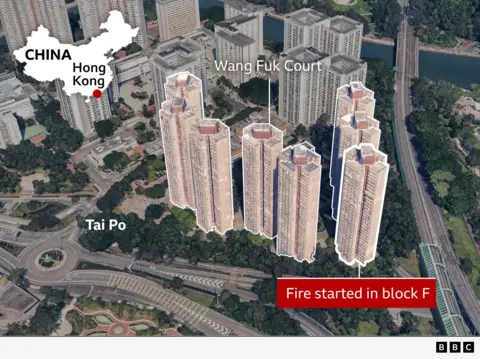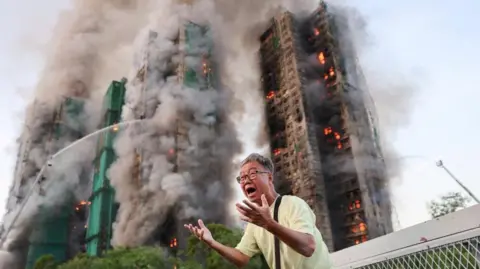Tiffany Wertheimerand
Yvette Tan
A devastating fire has ripped through a high-rise public housing complex in Hong Kong, killing at least 83 people, making it the city’s deadliest in more than 60 years. More than 270 people have been reported missing and thousands of residents are in evacuation shelters.
Several of the high-rise blocks were still ablaze the day after the fire broke out, with thick smoke billowing into the air, dominating the Chinese territory’s skyline.
Three men have been arrested on suspicion of manslaughter connected to the fire, according to local media reports, and an investigation has been launched.
Chinese President Xi Jinping has expressed condolences to victims, including a “firefighter who died in the line of duty”, state media report.
What caused the blaze is still unclear, but here is what we do know, so far.
Where and when did the fire start?
The blaze broke out at Wang Fuk Court, a large housing complex in Hong Kong’s Tai Po district, at 14:51 local time on Wednesday (06:51 GMT).
Wang Fuk Court consists of eight tower blocks, each 31 storeys high. Seven have been affected by the fire, Tai Po district councillor Mui Siu-fung told BBC Chinese. Built in 1983, the tower blocks were undergoing renovations when the fire broke out.
Tai Po is a residential district in the northern part of Hong Kong, near the city of Shenzhen on the Chinese mainland.
The complex provides 1,984 apartments for some 4,600 residents, according to a 2021 government census.
Nearly 40% of the people who lived in the Wang Fuk Court housing complex are at least 65, or older, according to the census.
Some of them have lived in the subsidised public housing estate since it was built.

What caused the fire?
The cause of the fire is unknown but a preliminary investigation found that the rapid speed at which it spread was unusual, Hong Kong’s security secretary said early on Thursday morning.
Police say a mesh material and plastic sheets were found on the outside of the buildings – both of which are not believed to be fireproof.
Styrofoam was also found on the building’s windows – and that, together with the other construction materials is likely to have caused the flames to spread so quickly, said police.
Police have arrested three men aged between 52 and 68 on suspicion of manslaughter in connection with the deadly blaze – two of them are directors of a construction firm while the other is an engineering consultant.
A police spokesperson said investigators were looking into the alleged actions, or failure to act, of the firm’s top officials.
“We have reason to believe that those in charge at the company were grossly negligent, which led to this accident and caused the fire to spread uncontrollably, resulting in major casualties,” said the spokesperson.
Local media reports also quote some residents who say the fire alarms in the building did not go off.
How serious is the fire?
This is Hong Kong’s deadliest fire in at least 63 years and has been classified as a level five alarm – the highest in severity.
Within 40 minutes of first being reported, it was declared a level four, but by 18:22, about three and a half hours later, the level was raised again.
Local media had earlier reported that explosions could be heard inside the building and fire hoses could not easily reach the higher levels.
The ferocity of the heat had prevented firefighters from entering the buildings to conduct rescue operations, deputy director of fire services Derek Armstrong Chan told media.
As well as 767 firefighters, 128 fire engines, 57 ambulances and some 400 police officers were deployed.
What do we know about the victims?
Among the dead is firefighter Ho Wai-ho, 37, who was with the service at Sha Tin Fire Station for nine years.
The fire service says it lost contact with him at 15:30, and about half an hour later, found that he had collapsed. He was taken to hospital but declared dead shortly after.
“I am profoundly grieved at the loss of this dedicated and gallant fireman,” said Andy Yeung, director of the fire service.
At least one other firefighter is in hospital, the Hong Kong fire service said.
Police officers have been helping residents search for family members by using a loudspeaker, say local media reports.
Where will evacuated residents stay?
Several emergency shelters have been set up to accommodate residents who were evacuated, the government said. The South China Morning Post reported that one of them – at Tung Cheong Street Sports Centre – was full, and residents were being directed to other shelters.
Another, the Kwong Fuk Community Hall, which is just over the road from the housing estate, was deemed unsafe. Evacuees were moved to another shelter, further away.
BBC Chinese reporter Gemini Cheng saw elderly residents, some using walking sticks or wheelchairs, arriving at some of the shelters.
At least 900 people are taking shelter in such temporary facilities, Agence France-Presse reports, quoting Lee.
Six schools in Tai Po will remain closed on Thursday, the Education Bureau announced, listing the affected schools on its website.
An emergency monitoring and support centre is in operation to manage the impact of the fire, security secretary Tang Ping-keung said in a statement.
A hotline for the public to ask about casualties has been set up by Hong Kong police.
What could have exacerbated the fire?
 Reuters
ReutersThe tower blocks at Wang Fuk Court are covered in bamboo scaffolding and green construction netting, right up to the rooftops, because they are undergoing renovations.
As mentioned earlier, police have attributed the quick spread of the fire to materials used in the renovation, such as mesh netting, plastic sheeting and styrofoam.
It’s still unclear how the fire began, but no matter its cause, proper netting on the buildings’ exterior would have been key to preventing its spread, Jason Poon, chairman of construction NGO China Monitor, told news outlet Initium Medi. Substandard netting could cause the fire to spread rapidly, he added.
Another engineer told Initium Media he believes that the vast majority of mesh netting used in construction across Hong Kong is not made of fire-retardant material.
Cardboard, debris and paint thinner is also often found on the scaffolding, which along with dry weather could hasten the spread of fire, the engineer said.
One fire safety expert the BBC spoke to said the bamboo scaffolding – a common part of the city’s urban landscape – also played a part in fanning the flames.
Local media reports in March said the government’s development bureau had been trying to phase out the use of bamboo because of safety concerns.
The push towards using metal instead of bamboo came after a spate of scaffolding-related deaths in Hong Kong, although reports said these were caused by falls and other safety failures, rather than fires.
Professor Jiang Liming from Hong Kong Polytechnic University also noted that the blocks at Wang Fuk Court were “relatively old” – they were built in the 1980s – so “the glass windows are not that fire resilient”.
“The modern buildings have double pane glass windows, but for this one they perhaps used just a single pane… [which makes it] very easy to be broken by the flames and the flames can then penetrate through the facade.”
Additional reporting by Jack Lau, BBC Global China Unit and Gemini Cheng, BBC Chinese in Hong Kong.


